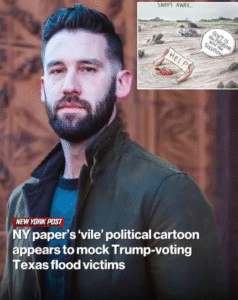A political cartoon published by a New York-based newspaper has sparked national outrage after critics claimed it mocked Texas flood victims who voted for former President Donald Trump. The cartoon, which appeared in the opinion section of the paper’s Sunday edition, depicted a flooded rural area with residents clinging to rooftops while a caricature of a man in a red MAGA hat shouted, “At least we didn’t vote for Biden!”
The drawing quickly drew backlash across social media and in political circles, with many accusing the publication of politicizing a deadly natural disaster and dehumanizing its victims. The state of Texas is currently recovering from a series of catastrophic floods that have killed dozens and displaced thousands, particularly in Trump-leaning counties.
Texas Governor Greg Abbott called the cartoon “disgusting and vile,” saying it showed “a complete lack of empathy for the people suffering right now.” He demanded an apology from the newspaper and called for media outlets to show “compassion, not contempt,” for Americans in crisis. Prominent Republican lawmakers and conservative commentators echoed the governor’s sentiment, slamming the cartoon as cruel and politically motivated.
Senator Ted Cruz described the image as “elitist garbage” and said it was emblematic of how “coastal media institutions view red-state Americans.” Fox News host Laura Ingraham went further, saying the cartoon “reveals the left’s disdain for working-class Americans who dare to think differently.” Online, hashtags like #MockingTheDead and #MediaBias began trending as thousands of users voiced their anger.
Even some left-leaning commentators criticized the cartoon for going too far. One journalist tweeted, “There’s a difference between critiquing political choices and mocking people whose lives have been destroyed. This was tone-deaf and tasteless.”
The cartoonist, whose name was initially withheld by the newspaper, later released a statement defending the work as “satire aimed at exposing political irony” but admitted that “in hindsight, the timing may have been poor given the human cost of the floods.” The cartoonist expressed sympathy for the victims and said the intent was never to make light of their suffering.
The newspaper’s editorial board also issued a response, saying the cartoon was meant to provoke discussion about political choices and climate change policy, but acknowledged that the backlash showed the image had struck a nerve. “We regret any pain caused to the families of flood victims,” the statement read. “While political satire plays a role in public discourse, it must be handled with sensitivity, especially during moments of human tragedy.”
The controversy has reignited debate over the role of political cartoons in modern journalism, with critics saying such content risks dehumanizing those on the receiving end, especially during times of crisis. Defenders argue that political cartoons have always walked a fine line between satire and provocation, and are a protected form of expression under the First Amendment.
Meanwhile, in Texas, where many communities remain underwater and emergency crews continue rescue efforts, the cartoon feels like a cruel slap in the face. “People are hurting,” said a flood survivor in Kerr County. “We’ve lost family, homes, everything. To see someone in New York laugh at that—it’s sickening.”
Calls for accountability continued to mount, with some readers threatening to boycott the newspaper and advertisers facing pressure to pull their support. Several media watchdog groups have also weighed in, some labeling the cartoon unethical, while others defended it under freedom of expression laws.
As recovery operations continue across Texas, the incident serves as a stark reminder of the deep political divides in the country and how they can be inflamed even in the face of shared tragedy. Many affected residents say they don’t want to be symbols of political satire—they just want help rebuilding their lives.
For now, the cartoon remains published online, though the paper has reportedly added a content warning. Whether that’s enough to calm the backlash remains to be seen. What’s clear is that, in the eyes of many, a line was crossed—and in a moment of pain and loss, satire gave way to offense.


